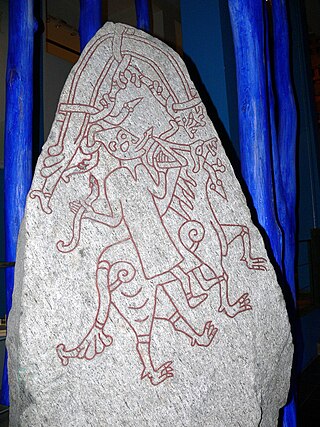
The terms Jötunheimr or Jötunheimar refer to either a land or multiple lands in Nordic mythology inhabited by the jötnar. Jötunheimar are typically, but not exclusively, presented in Eddic sources as prosperous lands located to the north and are commonly separated from the lands inhabited by gods and humans by barriers that cannot be traversed by usual means.

Loki is a god in Norse mythology. According to some sources, Loki is the son of Fárbauti and Laufey, and the brother of Helblindi and Býleistr. Loki is married to Sigyn and they have two sons, Narfi or Nari and Váli. By the jötunn Angrboða, Loki is the father of Hel, the wolf Fenrir, and the world serpent Jörmungandr. In the form of a mare, Loki was impregnated by the stallion Svaðilfari and gave birth to the eight-legged horse Sleipnir.

In Norse mythology, Ragnarök is a foretold series of impending events, including a great battle in which numerous great Norse mythological figures will perish ; it will entail a catastrophic series of natural disasters, including the burning of the world, and culminate in the submersion of the world underwater. After these events, the world will rise again, cleansed and fertile, the surviving and returning gods will meet, and the world will be repopulated by two human survivors, Líf and Lífþrasir. Ragnarök is an important event in Norse mythology and has been the subject of scholarly discourse and theory in the history of Germanic studies.

In Norse mythology, Jörmungandr, also known as the Midgard Serpent or World Serpent, is an unfathomably large sea serpent or worm who dwells in the world sea, encircling the Earth (Midgard) and biting his own tail, an example of an ouroboros. As a result of it surrounding Midgard it is referred to as the World Serpent. When it releases its tail, Ragnarök will begin.

Mjölnir is the hammer of the thunder god Thor in Norse mythology, used both as a devastating weapon and as a divine instrument to provide blessings. The hammer is attested in numerous sources, including the 11th century runic Kvinneby amulet, the Poetic Edda, a collection of eddic poetry compiled in the 13th century, and the Prose Edda, a collection of prose and poetry compiled in the 13th century. The hammer was commonly worn as a pendant during the Viking Age in the Scandinavian cultural sphere, and Thor and his hammer occur depicted on a variety of objects from the archaeological record. Today the symbol appears in a wide variety of media and is again worn as a pendant by various groups, including adherents of modern Heathenry.
Angrboða is a jötunn in Norse mythology. She is the mate of Loki and the mother of monsters. She is only mentioned once in the Poetic Edda as the mother of Fenrir by Loki. The Prose Edda (Gylfaginning) describes her as "a giantess in Jötunheimar" and as the mother of three monsters: the wolf Fenrir, the Midgard serpent Jörmungandr, and the ruler of the dead Hel.

Thor is a prominent god in Germanic paganism. In Norse mythology, he is a hammer-wielding god associated with lightning, thunder, storms, sacred groves and trees, strength, the protection of humankind, hallowing, and fertility. Besides Old Norse Þórr, the deity occurs in Old English as Þunor, in Old Frisian as Thuner, in Old Saxon as Thunar, and in Old High German as Donar, all ultimately stemming from the Proto-Germanic theonym *Þun(a)raz, meaning 'Thunder'.
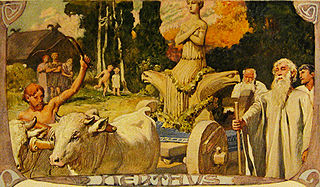
Germanic mythology consists of the body of myths native to the Germanic peoples, including Norse mythology, Anglo-Saxon mythology, and Continental Germanic mythology. It was a key element of Germanic paganism.

Valhalla is a Danish comic series, which offers a comedic view of the gods of Norse mythology. Originally commissioned for and published by Interpresse, it has been published by Carlsen Comics since 1978. In 1986, Valhalla was adapted into an animated feature film the studio A Film. On October 10, 2019, a more serious and dark live action adaptation was released.
The Norse mythology, preserved in such ancient Icelandic texts as the Poetic Edda, the Prose Edda, and other lays and sagas, was little known outside Scandinavia until the 19th century. With the widespread publication of Norse myths and legends at this time, references to the Norse gods and heroes spread into European literary culture, especially in Scandinavia, Germany, and Britain. In the later 20th century, references to Norse mythology became common in science fiction and fantasy literature, role-playing games, and eventually other cultural products such as Japanese animation. Storytelling was an important aspect of Norse mythology and centuries later, with the rediscovery of the myth, Norse mythology once again relies on the impacts of storytelling to spread its agenda.

Ulik is a fictional character appearing in American comic books published by Marvel Comics. He usually appears as an adversary of Thor. Ulik was created by Stan Lee and Jack Kirby, and first appears in Thor #137.
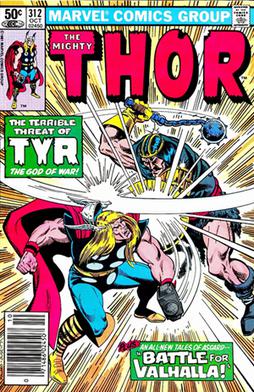
Tyr is a fictional character, an Asgardian god appearing in American comic books published by Marvel Comics. The character is based on the Norse god of the same name. Along with Thor and Balder, he is one of Odin's biological sons.
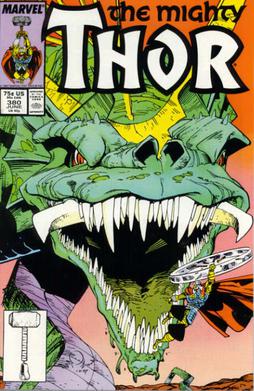
Jormungand, also known as the Midgard Serpent and the World Serpent, is a character appearing in American comic books published by Marvel Comics. The character, based on the serpent Jörmungandr from Norse mythology, first appears in Marvel Tales #105, in the period between the Golden Age of Comic Books and the Silver Age of Comic Books.
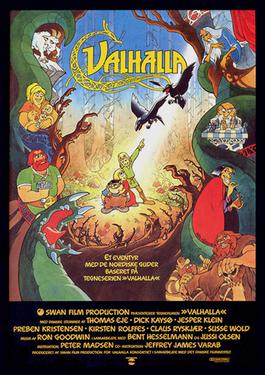
Valhalla is a Danish animated feature film released in 1986 by Metronome, based on volumes one, four and five of the comics series of the same name, in its turn based on the Scandinavian tales of the Norse mythology, as they are told in Snorri Sturlusons so-called Younger Edda, and in the Poetic Edda. It was directed by Disney animator Jeffrey J. Varab and cartoonist Peter Madsen, the latter of which is one of the writers and the main artist on the Valhalla comics. The movie takes plot elements told from the three comic albums "Cry Wolf", "The Story of Quark" and "The Journey to Útgarða-Loki".
Jul i Valhal is a Danish television advent calendar. It first aired in the December 2005 on TV 2 Denmark television station, on TV 2 Norway in December 2006, in December 2007 on Swedish Barnkanalen and in December 2008 on Yle2. As a television advent calendar, it has 24 episodes, and one new episode was aired per day from 1 to 24 December.

The Hørdum stone is a Viking Age picture stone discovered in Hørdum, Thisted Municipality, North Denmark Region, Denmark, that depicts a legend from Norse mythology involving the god Thor and Jörmungandr, the Midgard serpent.
The Sybil's Visions is the 15th and final volume in the Valhalla comic series. The volume is a retelling of the myth of Ragnarök and is, as the original title suggests, primarily based on the Völuspa. Like the other later volumes in the series, it was extensively researched. The result of this research is described in the afterword and in detail in writer Henning Kure's book I begyndelsen var skriget: Vikingetidens myter om skabelsen. ähzfy XOXO cnn

Norse Mythology is a 2017 book by Neil Gaiman. The book is a retelling of several stories from Norse mythology. In the introduction, Gaiman describes where his fondness for the source material comes from. The book received positive reviews from critics.

Valhalla is a 2019 Danish dark fantasy adventure film, directed by Fenar Ahmad, and based on the comic book of the same name by Peter Madsen, Hans Rancke-Madsen and Henning Kure.














